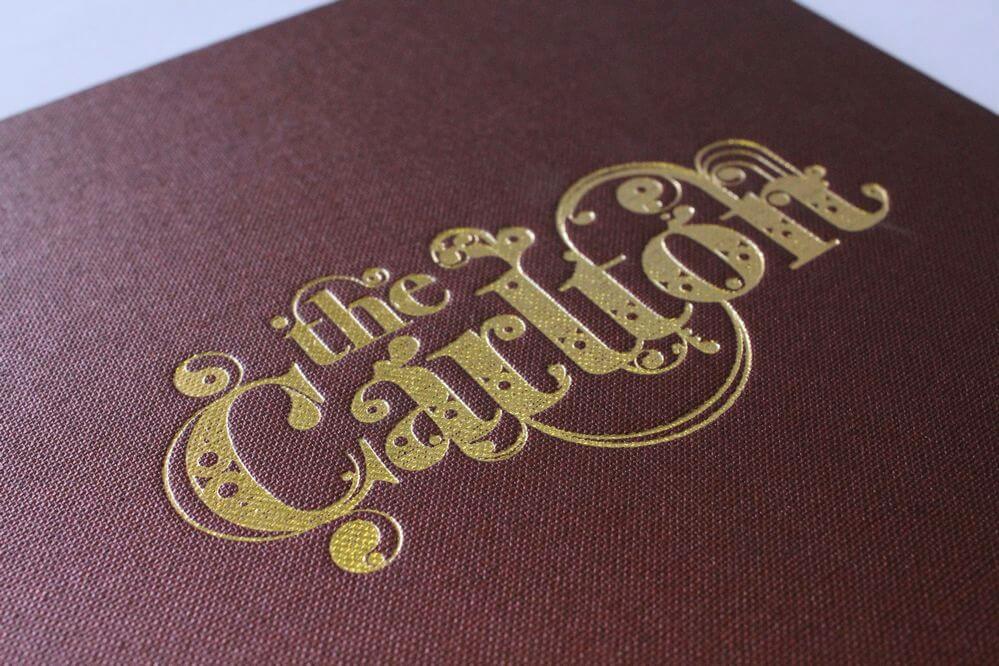Gold foiling is a technique where a thin layer of gold is applied to a surface. It adds a luxurious and shiny finish to various items like packaging, stationery, and more.
Gold foiling is a process where a thin layer of gold is applied to a surface using heat and pressure. It involves transferring a metallic foil onto the desired material, creating a shiny and eye-catching effect. This technique is commonly used in various industries, including packaging, printing, and stationery. The process typically involves applying an adhesive to the surface, placing the gold foil on top, and then using a heated die or press to transfer the foil onto the material. The result is a beautiful and elegant finish that adds a touch of luxury to any item.
Gold foiling can be used on different materials like paper, cardboard, leather, and even fabric. It’s a popular choice for adding a special and premium touch to products like business cards, invitations, book covers, and packaging boxes. The reflective properties of gold foiling make it highly attractive and attention-grabbing, making it a great option for creating a memorable and high-end look.
Table of Contents
ToggleProcess of Gold Foiling:
Sure, let me explain the process of gold foiling in detail. First, an adhesive or glue is applied to the surface where you want to apply the gold foil. Then, the gold foil is carefully placed on top of the adhesive, making sure it covers the desired area. Next, pressure is applied using a heated die or press. The heat activates the adhesive, allowing it to bond with the gold foil.
The pressure ensures that the foil adheres evenly and smoothly to the surface. After a few seconds, the die or press is lifted, and the excess foil is removed, leaving behind the desired gold foiled design. The result is a beautiful, shiny, and luxurious finish that adds a touch of elegance to any item. Gold foiling is commonly used in various industries, including packaging, stationery, and printing, to create eye-catching and premium-looking products.
Technique of Gold Foiling:
In gold foiling, a technique called hot stamping is commonly used. It involves transferring a thin layer of metallic foil onto a surface using heat and pressure. The process typically includes the following steps:
- Design preparation: The desired design or pattern is created or prepared on a computer using graphic design software. This design is then converted into a metal die or plate.
- Foil Selection: The appropriate type and color of foil, such as gold, silver, or other metallic shades, are chosen based on the desired outcome.
- Die Preparation: The metal die or plate, which contains the negative impression of the design, is heated to a specific temperature.
- Foil Placement: A roll of metallic foil is positioned between the heated die and the substrate (the material to be foiled), with the foil side facing down.
- Application: The heated die is pressed onto the foil, causing it to adhere to the substrate through heat and pressure. The foil transfers onto the substrate, taking on the shape of the design on the die.
- Cooling and Removal: After a brief cooling period, the die is lifted, leaving behind the foiled design on the substrate. The excess foil is removed, and the final foiled product is obtained.
This technique allows for precise and detailed foiling, creating a luxurious and eye-catching effect on various surfaces like paper, cardboard, leather, or fabric. It is commonly used in packaging, stationery, invitations, book covers, and other printed materials.
Machinery Used in Gold Foiling:
Sure, let me explain in detail. In gold foiling, the machinery used includes a hot stamping machine or a foil stamping press. These machines are specifically designed for the process of gold foiling and are equipped with heating elements and pressure mechanisms.
The hot stamping machine consists of a heated plate or die that is heated to the desired temperature. The gold foil is placed on the surface to be foiled, and the heated die is pressed onto it. The combination of heat and pressure activates the adhesive on the foil, allowing it to adhere to the surface. The machine ensures that the heat and pressure are applied evenly, resulting in a smooth and consistent foiled finish.
Similarly, a foil stamping press operates on a similar principle. It consists of a heated plate or roller and a counter-pressure system. The gold foil is placed on the surface, and the heated plate or roller applies heat and pressure onto the foil, transferring it onto the surface. The press ensures precise control of temperature, pressure, and timing, resulting in accurate and high-quality foiling. Both machines are capable of handling various materials like paper, cardboard, and even some fabrics. They provide efficient and reliable foiling processes, allowing for the creation of stunning and luxurious designs.
It’s worth noting that while these machines are commonly used for gold foiling, they can also be used for other types of foiling, such as silver, copper, or holographic foiling. The choice of machinery depends on the specific requirements and desired outcome of the foiling project.
Benefits Used in Gold Foiling:
Gold foiling offers several benefits. It adds a touch of luxury and elegance to products, making them stand out. The shiny and reflective properties of gold foil create a visually appealing and eye-catching effect. It can enhance the perceived value of a product, making it more desirable to customers. Gold foiling is also durable and long-lasting, ensuring that the design stays intact over time. Additionally, it can be applied to various materials like paper, cardboard, and even fabric, allowing for versatility in design options. Overall, gold foiling is a great way to elevate the look and feel of products and make them more memorable.
Uses of Gold Foiling:
Gold foiling has several uses across different industries. It is commonly used in packaging to create a luxurious and eye-catching look. Gold foiling is also popular in stationery, invitations, and business cards to add a touch of elegance.
Additionally, it is used in the printing industry for book covers, magazine covers, and promotional materials. In the craft and DIY world, gold foiling is used for various art projects, scrapbooking, and home décor items. Its versatility and visual appeal make it a popular choice for adding a touch of luxury and sophistication to a wide range of products.
Purpose of Gold Foiling:
The purpose of gold foiling is to add a touch of luxury, elegance, and visual appeal to various products. It enhances their perceived value and makes them stand out. Gold foiling is commonly used in packaging, stationery, invitations, and other items where a premium and eye-catching look is desired.
Gold foiling serves multiple purposes in various industries. Here are some detailed explanations:
- Enhancing Visual Appeal: Gold foiling adds a luxurious and captivating element to products. The shimmering and reflective properties of gold foil create an eye-catching effect that grabs attention and makes products stand out.
- Elevating Perceived Value: The addition of gold foil to packaging, stationery, or other items can give them a premium and high-quality appearance. This can influence customers’ perception of the product’s value, making it more desirable and potentially increasing its perceived worth.
- Creating a Sense Of Exclusivity: Gold foiling can convey a sense of exclusivity and prestige. It is often associated with high-end and luxury brands, making products feel more special and unique.
- Adding a Touch of Elegance: The rich, warm tones of gold foil exude elegance and sophistication. It can elevate the overall aesthetic of a design, making it more refined and visually appealing.
- Providing Durability: Gold foiling is durable and long-lasting. It resists wear and tear, ensuring that the foiled design remains intact over time. This durability contributes to the longevity of the product’s visual appeal.
- Versatility In Design: Gold foiling can be applied to various materials, including paper, cardboard, fabric, and even glass. This versatility allows for creative freedom in design choices, enabling unique and customized applications.
Overall, the purpose of gold foiling is to enhance the visual appeal, perceived value, and exclusivity of products, while adding a touch of elegance and durability. It is a versatile technique that can elevate various items and make them more visually captivating.
Advantages of Gold Foiling:
Gold foiling offers several advantages that contribute to its popularity in various industries. Here are some detailed explanations:
- Luxurious And Eye-Catching: foiling adds a touch of luxury and sophistication to products. Its shimmering and reflective properties create a visually captivating effect that grabs attention and makes products stand out.
- Enhanced and perceived Value: The addition of gold foil to packaging, stationery, or other items can elevate their perceived value. The luxurious appearance of gold foil can influence customers’ perception of the product’s worth, making it more desirable and potentially increasing its perceived quality.
- Premium Aesthetic: The rich and warm tones of gold foil exude elegance and class. It enhances the overall aesthetic of a design, making it more visually appealing and giving it a premium look.
- Versatility: Gold foiling can be applied to various materials, including paper, cardboard, fabric, and even glass. This versatility allows for creative freedom in design choices, enabling unique and customized applications.
- Durability: Gold foil is durable and long-lasting. It resists wear and tear, ensuring that the foiled design remains intact over time. This durability contributes to the longevity of the product’s visual appeal.
- Customization Option: Gold foiling can be customized to suit specific design preferences. It can be combined with other printing techniques, such as embossing or debossing, to create intricate and visually stunning effects.
- Brand Differentiate: The use of gold foiling can help a brand stand out from competitors. It adds a distinctive and premium touch to packaging or marketing materials, making them instantly recognizable and memorable.
- Perceived Quality: Gold foiling is often associated with high-end and luxury products. Incorporating gold foil into a design can enhance the perceived quality of the product, giving customers a positive impression and building trust in the brand.
Overall, the advantages of gold foiling lie in its ability to create a luxurious, visually appealing, and premium look, while also offering versatility and customization options. It is a powerful tool for enhancing brand image and product presentation.
Disadvantages of Gold Foiling:
While gold foiling has numerous advantages, it also has a few disadvantages to consider:
- Cost: Gold foiling can be more expensive compared to other printing techniques. The cost of the gold foil material itself, as well as the specialized equipment and expertise required for application, can contribute to higher production costs.
- Limited color option: Gold foiling is primarily available in gold tones, which may limit the color options for designs. If you require a wide range of colors or specific shades, other printing techniques may offer more flexibility.
- Fragility: Although gold foil is durable, it can be more prone to scratching or chipping compared to other finishes. Care must be taken during handling and transportation to prevent damage to the foiled areas.
- Design Limitations: The intricate nature of gold foiling may impose certain design limitations. Fine details or small text may not translate well in the foiling process, potentially leading to less crisp or legible results.
- Production Time: Gold foiling requires additional time for setup and application compared to standard printing methods. This can extend production timelines, especially for large quantities or complex designs.
- Environmental Gold foiling typically involves the use of metallic materials, which may have an impact on the environment. It is important to consider sustainable alternatives or proper waste management practices when using gold foiling.
Despite these disadvantages, gold foiling remains a popular choice for adding a touch of luxury and sophistication to various products. It is essential to weigh the pros and cons to determine if gold foiling aligns with your specific needs and budget.
Conclusion:
In conclusion, gold foiling offers a range of benefits and considerations to keep in mind. On the positive side, it adds a touch of elegance and luxury to various products, making them visually appealing and attention-grabbing. The metallic finish of gold foiling can enhance the perceived value of a product and create a memorable impression. It is a versatile technique that can be applied to different materials, such as paper, cardboard, or fabric.
However, there are also a few drawbacks to consider. Gold foiling can be more expensive compared to other printing techniques, and it may have limitations in terms of color options and design complexity. The foiled areas can be more fragile and require careful handling to prevent damage.
Additionally, the production process for gold foiling may take longer due to setup and application requirements. Overall, gold foiling can be a fantastic choice for adding a touch of sophistication and luxury to your designs, but it’s important to weigh the costs, limitations, and production considerations to ensure it align with your specific needs and budget.
for more info and custom packaging boxes order email us on: sales@vividprintinghub.com






